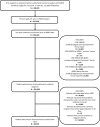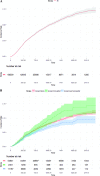The Impact of Surgical Approach on Late Recurrence in Incisional Hernia Repair
- PMID: 30607103
- PMCID: PMC6305066
- DOI: 10.4293/JSLS.2018.00053
The Impact of Surgical Approach on Late Recurrence in Incisional Hernia Repair
Abstract
Background and objectives: We conducted a retrospective, observational study to compare real-world recurrence rates for different surgical approaches after incisional hernia mesh repair.
Methods: Two large US insurance claims databases, Truven Commercial Claims (CCAE) and Medicare Supplemental (MDCR), were evaluated for the period from 2009 to 2015. The first incisional hernia repair with mesh for patients 21 years or older was identified (INDEX). One-year continuous enrollment before INDEX was required. Mesh and approach (OPEN, laparoscopic [LAP], and conversion [CONV]) were identified with the use of CPT-4/ICD-9 codes. Recurrence was defined as a second incisional hernia repair 31 days or longer after INDEX. Kaplan-Meier (KM) estimates and Cox models were used to analyze the effect of approach on recurrence.
Results: A total of 68,560 patients were identified for CCAE (78.7%) and MDCR (21.3%) with a mean (SD) age of 55.3 (12.8) years. The majority of procedures were OPEN (80.1%) followed by LAP (16.3%) and CONV (3.6%). OPEN had fewer female patients 53.7% compared with LAP (62.1%) and CONV (62.2%). CONV represented more inpatient (51.9%) procedures compared with LAP (41.0%) and OPEN (27.3%). Starting at 2 years post-INDEX, LAP (5.1%, 95% confidence interval [CI] 4.5%-5.6%) had lower KM estimates compared with OPEN (5.9%, 95% CI 5.7%-6.2%]); after 3 years, LAP (6.8%, 95% CI 6.2%-7.5%]) had lower estimates than both OPEN (7.9%, 95% CI 7.6%-8.3%) and CONV (9.3%, 95% CI 7.6%-11.0%). After controlling for confounders, the risk was lower for LAP compared with OPEN (hazard ratio 0.839, 95% CI 0.752-0.936) and CONV (hazard ratio 0.808, 95% CI 0.746-0.875), while OPEN and CONV were not significantly different from each other.
Conclusion: Successful laparoscopic surgery incisional hernia mesh repair was associated with decreased risk of recurrence compared with OPEN and CONV.
Keywords: Conversion; Incisional hernia; Laparoscopic; Mesh; Recurrence.
Conflict of interest statement
Conflicts of Interest: All authors declare no conflict of interest regarding the publication of this article.
Figures
References
-
- Poulose BK, Shelton J, Phillips S, et al. Epidemiology and cost of ventral hernia repair: making the case for hernia research. Hernia. 2012;16:179–183. - PubMed
-
- American College of Surgeons. Ventral hernia repair. Surgical Patient Education 2014. https://www.facs.org/∼/media/files/education/patient%20ed/ventral_hernia... Accessed may 12, 2017.
-
- Earle D, Roth JS, Saber A, et al. SAGES guidelines for laparoscopic ventral hernia repair. Surg Endosc. 2016;30:3163–3183. - PubMed
-
- Ballem N, Parikh R, Berber E, Siperstein A. Laparoscopic versus open ventral hernia repairs: 5 year recurrence rates. Surg Endosc. 2008;22:1935–1940. - PubMed
Publication types
MeSH terms
LinkOut - more resources
Full Text Sources
Research Materials
Miscellaneous


